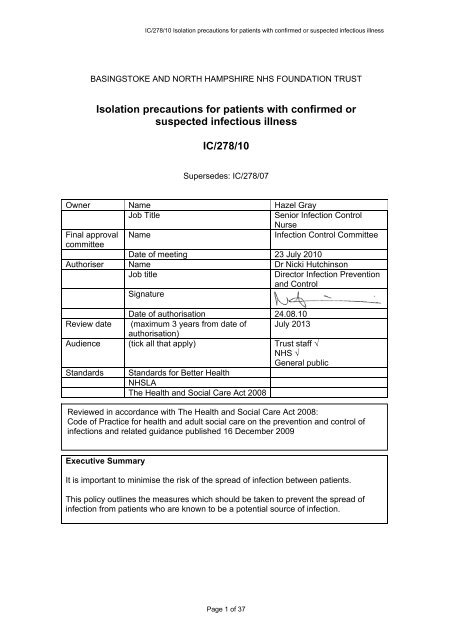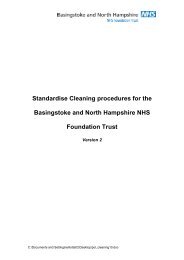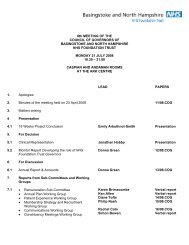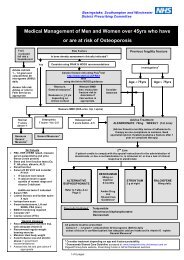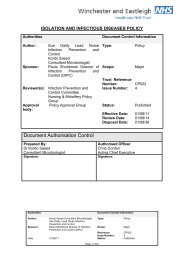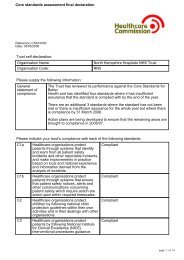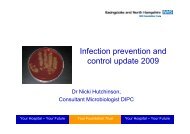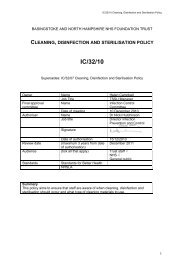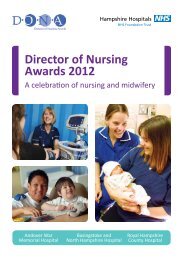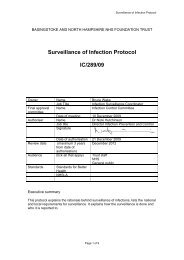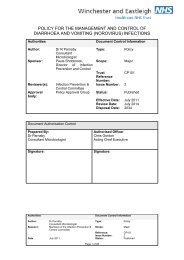Isolation precautions for patients with confirmed or suspected ...
Isolation precautions for patients with confirmed or suspected ...
Isolation precautions for patients with confirmed or suspected ...
Create successful ePaper yourself
Turn your PDF publications into a flip-book with our unique Google optimized e-Paper software.
IC/278/10 <strong>Isolation</strong> <strong>precautions</strong> <strong>f<strong>or</strong></strong> <strong>patients</strong> <strong>with</strong> <strong>confirmed</strong> <strong>or</strong> <strong>suspected</strong> infectious illness<br />
BASINGSTOKE AND NORTH HAMPSHIRE NHS FOUNDATION TRUST<br />
<strong>Isolation</strong> <strong>precautions</strong> <strong>f<strong>or</strong></strong> <strong>patients</strong> <strong>with</strong> <strong>confirmed</strong> <strong>or</strong><br />
<strong>suspected</strong> infectious illness<br />
IC/278/10<br />
Supersedes: IC/278/07<br />
Owner Name Hazel Gray<br />
Job Title<br />
Seni<strong>or</strong> Infection Control<br />
Nurse<br />
Final approval Name<br />
Infection Control Committee<br />
committee<br />
Date of meeting 23 July 2010<br />
Auth<strong>or</strong>iser Name Dr Nicki Hutchinson<br />
Job title<br />
Direct<strong>or</strong> Infection Prevention<br />
and Control<br />
Signature<br />
Date of auth<strong>or</strong>isation 24.08.10<br />
Review date (maximum 3 years from date of July 2013<br />
auth<strong>or</strong>isation)<br />
Audience (tick all that apply) Trust staff √<br />
NHS √<br />
General public<br />
Standards Standards <strong>f<strong>or</strong></strong> Better Health<br />
NHSLA<br />
The Health and Social Care Act 2008<br />
Reviewed in acc<strong>or</strong>dance <strong>with</strong> The Health and Social Care Act 2008:<br />
Code of Practice <strong>f<strong>or</strong></strong> health and adult social care on the prevention and control of<br />
infections and related guidance published 16 December 2009<br />
Executive Summary<br />
It is imp<strong>or</strong>tant to minimise the risk of the spread of infection between <strong>patients</strong>.<br />
This policy outlines the measures which should be taken to prevent the spread of<br />
infection from <strong>patients</strong> who are known to be a potential source of infection.<br />
Page 1 of 37
IC/278/10 <strong>Isolation</strong> <strong>precautions</strong> <strong>f<strong>or</strong></strong> <strong>patients</strong> <strong>with</strong> <strong>confirmed</strong> <strong>or</strong> <strong>suspected</strong> infectious illness<br />
Implementation Plan<br />
Summary of changes<br />
• Contact number changes<br />
• <strong>Isolation</strong> sign changes<br />
• Roles and responsibility<br />
• Education<br />
• Evaluation of policy<br />
• Standard Precautions update<br />
Action needed and owner of action<br />
• All staff need to be aware of which <strong>patients</strong> may need isolating and what type<br />
of isolation is necessary<br />
• All staff need to be aware of the role they play in trying to reduce the spread<br />
of infection<br />
• All staff need to adhere to this policy<br />
• The Infection prevention and control team IPCT will evaluate policy when<br />
required<br />
• The IPCT will monit<strong>or</strong> infection rates via alert <strong>or</strong>ganism surveillance<br />
Page 2 of 37
IC/278/10 <strong>Isolation</strong> <strong>precautions</strong> <strong>f<strong>or</strong></strong> <strong>patients</strong> <strong>with</strong> <strong>confirmed</strong> <strong>or</strong> <strong>suspected</strong> infectious illness<br />
Contents:<br />
Page<br />
1.0 Summary 4<br />
1.1 Roles and Responsibilities 4<br />
1.2 Education and training 5<br />
1.3 Evaluation of this policy 5<br />
2.0 Introduction 5<br />
3.0 Policy Objectives 5<br />
4.0 Categ<strong>or</strong>ies of isolation 6<br />
4.1 Ring fencing 6<br />
4.2 Source isolation 6<br />
4.3 Protective isolation 6<br />
5.1 Source isolation 7<br />
5.2 Patient placement 7<br />
5.3 Preparation of the isolation room 8<br />
5.4 Hand Decontamination 8<br />
5.5 What if you have cuts and breaks in your skin? 9<br />
5.6 Hand hygiene - patient 9<br />
5.7 Gloves 9<br />
5.8 Aprons and gowns 9<br />
5.9 Masks, face shields <strong>or</strong> eye protection 10<br />
5.10 Patient care equipment 10<br />
5.11 Environmental cleaning 10<br />
5.12 Linen 10<br />
5.13 Sharps Management 10<br />
5.14 Crockery/cutlery 11<br />
5.15 Bathing 11<br />
5.16 Transp<strong>or</strong>t of infected <strong>patients</strong> 12<br />
5.17 Visit<strong>or</strong>s/<strong>patients</strong>/carers 12<br />
6.0 References and further reading 12<br />
Appendix 1: Diarrhoea and/<strong>or</strong> Vomiting Risk Assessment Alg<strong>or</strong>ithm 13<br />
Appendix 2: Respirat<strong>or</strong>y Risk Assessment 14<br />
Appendix 3: Skin Infection Risk Assessment Alg<strong>or</strong>ithm 14<br />
Appendix 4: <strong>Isolation</strong> Pri<strong>or</strong>ities 16<br />
Appendix 5: Risk Assessment using the <strong>Isolation</strong> Pri<strong>or</strong>ity Sc<strong>or</strong>ing 17<br />
System<br />
Appendix 6: Pri<strong>or</strong>ity Sc<strong>or</strong>ing System: Infectious Diarrhoea 18<br />
Appendix 7: Pri<strong>or</strong>ity Sc<strong>or</strong>ing System: MRSA 19<br />
Appendix 8: Pri<strong>or</strong>ity Sc<strong>or</strong>ing System: Antimicrobial-Resistant 20<br />
Bacteria<br />
Appendix 9: Pri<strong>or</strong>ity Sc<strong>or</strong>ing System: Respirat<strong>or</strong>y Infections 21<br />
Appendix 10: Pri<strong>or</strong>ity Sc<strong>or</strong>ing System: Other Infectious Diseases / 22<br />
Conditions<br />
Appendix 11: Components of standard and transmission based 23<br />
isolation <strong>precautions</strong><br />
Appendix 12: Signage 24<br />
Appendix 13: Cleaning Procedure <strong>f<strong>or</strong></strong> a Vacated Single <strong>Isolation</strong> 27<br />
Room<br />
Appendix 14: Cleaning Procedure <strong>f<strong>or</strong></strong> a Single <strong>Isolation</strong> Room 28<br />
Appendix 15: Notifiable infectious diseases & food poisoning 29<br />
Page 3 of 37
IC/278/10 <strong>Isolation</strong> <strong>precautions</strong> <strong>f<strong>or</strong></strong> <strong>patients</strong> <strong>with</strong> <strong>confirmed</strong> <strong>or</strong> <strong>suspected</strong> infectious illness<br />
1.0 Summary<br />
<strong>Isolation</strong> <strong>precautions</strong> are adopted to minimise the risk of spread of an infectious<br />
disease in the hospital setting. This policy is based on national guidelines that review<br />
and require assurance that there is a managed environment, which minimises the<br />
risk of infection to <strong>patients</strong>, staff and visit<strong>or</strong>s.<br />
This policy is limited to the description of isolation <strong>precautions</strong> and must be<br />
supplemented by the relevant hospital policies and procedures <strong>f<strong>or</strong></strong> other aspects of<br />
infection and environmental control, occupational health, administrative and legal<br />
issues, and any other issues beyond the scope of this guideline.<br />
The policy uses a two-tier approach to isolation of <strong>patients</strong>: standard <strong>precautions</strong>,<br />
which should be used <strong>f<strong>or</strong></strong> ALL in<strong>patients</strong> and transmission based <strong>precautions</strong>.<br />
Transmission based <strong>precautions</strong> use the likely pathogen and its’ mode of spread as<br />
the main determinant of type of <strong>precautions</strong> required. There<strong>f<strong>or</strong></strong>e these <strong>precautions</strong><br />
are classified by these 3 main transmission vehicles contact, droplet and air b<strong>or</strong>ne.<br />
The policy contains quick reference guidance attached as appendages. They are:<br />
• Standard, airb<strong>or</strong>ne, droplet and contact <strong>precautions</strong><br />
• Applications of standard <strong>precautions</strong><br />
• Type and duration of <strong>precautions</strong> needed <strong>f<strong>or</strong></strong> selected infections<br />
• Empiric isolation <strong>precautions</strong> <strong>f<strong>or</strong></strong> clinical conditions to prevent spread pending<br />
confirmation of diagnosis<br />
• <strong>Isolation</strong> signs<br />
• Cleaning procedure <strong>f<strong>or</strong></strong> vacated room<br />
• Daily cleaning procedure <strong>f<strong>or</strong></strong> a single isolation room<br />
• Notifiable infectious diseases (see Appendix 15)<br />
Risk assessment should precede isolation of <strong>patients</strong> especially when single rooms<br />
are in sh<strong>or</strong>t supply and patient isolation has to be pri<strong>or</strong>itised. Some new flowcharts<br />
have been added to this document to try and help you <strong>with</strong> this process (please see<br />
Appendices 1-5).<br />
The decision to isolate a patient should always be discussed <strong>with</strong> the infection<br />
prevention and control team. The decision to isolate/close a whole ward/s will be<br />
undertaken by a Consultant Microbiologist.<br />
F<strong>or</strong> further in<strong>f<strong>or</strong></strong>mation and/<strong>or</strong> assistance contact the infection control team on<br />
extension 6774 <strong>or</strong> via bleeps.<br />
Hazel Gray }<br />
Linda Swanson } Bleep 2364<br />
Out of hours, please contact a Consultant Microbiologist via the switchboard.<br />
1.1 Roles and Responsibility<br />
The Executive Direct<strong>or</strong> of Nursing on behalf of the Chief Executive will ensure that<br />
the Clinical Direct<strong>or</strong>s take clinical ownership of the policy.<br />
The Clinical Direct<strong>or</strong>s on behalf of the executive direct<strong>or</strong> of nursing will ensure that:<br />
• all health care w<strong>or</strong>kers comply <strong>with</strong> this policy<br />
• all healthcare w<strong>or</strong>kers attend mandat<strong>or</strong>y infection control training<br />
Page 4 of 37
IC/278/10 <strong>Isolation</strong> <strong>precautions</strong> <strong>f<strong>or</strong></strong> <strong>patients</strong> <strong>with</strong> <strong>confirmed</strong> <strong>or</strong> <strong>suspected</strong> infectious illness<br />
The Seni<strong>or</strong> Nurses and Matrons on behalf of the Executive Direct<strong>or</strong> of Nursing and<br />
the Clinical Direct<strong>or</strong>s will ensure that:<br />
• all health care w<strong>or</strong>kers comply <strong>with</strong> this policy<br />
• all healthcare w<strong>or</strong>kers attend mandat<strong>or</strong>y training<br />
The infection prevention and control team will:<br />
• act as a resource <strong>f<strong>or</strong></strong> in<strong>f<strong>or</strong></strong>mation and supp<strong>or</strong>t<br />
• monit<strong>or</strong> the implementation of this policy <strong>with</strong>in clinical areas<br />
• regularly review and update the policy<br />
The seni<strong>or</strong> nurse and doct<strong>or</strong> must ensure that all staff are aware and comply <strong>with</strong><br />
the infection control <strong>precautions</strong> that need to be taken and follow the advice in this<br />
policy.<br />
1.2 Education and training<br />
All staff that may come into contact <strong>with</strong> either potential <strong>or</strong> <strong>confirmed</strong> infectious<br />
<strong>patients</strong> i.e. clinical staff; p<strong>or</strong>ters, domestics etc must attend their annual infection<br />
control mandat<strong>or</strong>y training session.<br />
1.3 Evaluation of this policy<br />
It is imp<strong>or</strong>tant to minimise the risk of the spread of infection to and from <strong>patients</strong> and<br />
staff. This policy outlines the measures, which should be taken to prevent the spread<br />
of infection from <strong>patients</strong> who are known to be a potential source of infection. This<br />
can be monit<strong>or</strong>ed by:<br />
• monit<strong>or</strong>ing the trends of infections in the trust by analyzing alert <strong>or</strong>ganism<br />
figures<br />
• ensuring when timely isolation of infected <strong>patients</strong> cannot occur that<br />
untoward incident <strong>f<strong>or</strong></strong>ms are filled in<br />
• monit<strong>or</strong>ing that the c<strong>or</strong>rect signage and isolation guidelines are adhered<br />
to by all staff by undertaken ad hoc observational audits<br />
• ensuring that non compliance to the policy is challenged<br />
2.0 Introduction<br />
Aim of the policy is to ensure that source isolation procedures are instigated in <strong>or</strong>der<br />
to minimise the risks of cross infection. The c<strong>or</strong>rect and timely placement of infected<br />
<strong>patients</strong> (<strong>suspected</strong> <strong>or</strong> proven) into single rooms can be very effective in reducing the<br />
overall numbers of infective <strong>patients</strong> (DH 2007).<br />
It is also a requirement of the Health Act 2008 (DH) that an evidence based isolation<br />
policy exists inc<strong>or</strong>p<strong>or</strong>ating local risk assessment findings and measures. This policy<br />
must include indications and procedures <strong>f<strong>or</strong></strong> the infection control management of<br />
isolated <strong>patients</strong>.<br />
3.0 Policy Objectives<br />
• To identify <strong>patients</strong> presenting <strong>with</strong> colonisation, infection <strong>or</strong> infectious<br />
diseases that may be a risk to others.<br />
• To take timely action to prevent the spread of potentially infectious conditions<br />
by appropriate isolation of the source patient and the appropriate use of<br />
personal protective equipment.<br />
• To ensure that <strong>patients</strong> at high risk of infections due to immunosuppression <strong>or</strong><br />
neutropenia are appropriately isolated and protected to minimise the<br />
acquisition of such infections. (Please see Trust Protective <strong>Isolation</strong> Policy)<br />
Page 5 of 37
IC/278/10 <strong>Isolation</strong> <strong>precautions</strong> <strong>f<strong>or</strong></strong> <strong>patients</strong> <strong>with</strong> <strong>confirmed</strong> <strong>or</strong> <strong>suspected</strong> infectious illness<br />
• To ensure that all staff, departments and any outside agencies likely to be<br />
involved in the care of <strong>patients</strong> care have a clear understanding of their roles<br />
and responsibilities in preventing the spread of infection.<br />
4.0 Categ<strong>or</strong>ies of isolation<br />
<strong>Isolation</strong> must not compromise the clinical care of the patient<br />
There are two categ<strong>or</strong>ies of isolation (Ayliffe 2001):<br />
• Source isolation: when a patient poses an infection risk to others<br />
• Protective isolation: when a patient is at risk from others<br />
4.1 Ring fencing<br />
It is sometimes necessary to ring fence a high-risk area e.g. Orthopaedic <strong>or</strong> Surgical<br />
Units as a protective isolation measure. This is due to the significant implications of<br />
infections amongst these <strong>patients</strong>. When an area is ring fenced admissions are<br />
scrutinised to allow ONLY specific groups of <strong>patients</strong> sharing the same medical<br />
conditions and risk fact<strong>or</strong>s <strong>f<strong>or</strong></strong> infection, to be admitted to the ring fenced area. Ring<br />
fencing w<strong>or</strong>ks as part of a complete infection control programme <strong>with</strong> active<br />
surveillance. It also allows <strong>f<strong>or</strong></strong> national targets to be met.<br />
The decision to ring fence an area should be undertaken between the Hospital<br />
Infection Control doct<strong>or</strong>, direct<strong>or</strong>ate leads and trust management teams.<br />
4.2 Source isolation<br />
Source isolation is the physical separation of one patient from another, in <strong>or</strong>der to<br />
prevent the spread of infection. Single room isolation will not by itself prevent the<br />
transmission of <strong>or</strong>ganisms; it should be used in conjunction <strong>with</strong> standard (universal)<br />
infection control <strong>precautions</strong> which must be observed at all times <strong>with</strong> all <strong>patients</strong>.<br />
Additional <strong>precautions</strong> may need to be implemented dependant on the source and<br />
mode of spread.<br />
All hospitals providing in-patient care must ensure that they are able to provide <strong>or</strong><br />
secure the provision of adequate isolation facilities <strong>f<strong>or</strong></strong> <strong>patients</strong> sufficient to prevent <strong>or</strong><br />
minimise the spread of Healthcare Associated Infection (DOH 2000) Hospital Trusts<br />
have a responsibility to ensure that the policy includes the potential risk of infection<br />
and the use of effective protective measures and equipment (DOH 2006)<br />
4.3 Protective <strong>Isolation</strong><br />
Protective isolation is the physical separation of <strong>patients</strong> who are<br />
Immunocompromised / Immunosuppressed in <strong>or</strong>der to prevent the acquisition of<br />
infection from other <strong>patients</strong>, staff <strong>or</strong> visit<strong>or</strong>s. (Please see separate Trust Protective<br />
<strong>Isolation</strong> Policy IC/201/10).<br />
In both categ<strong>or</strong>ies:<br />
• The decision to isolate a patient should be based on the infection risk to other<br />
<strong>patients</strong>, staff and visit<strong>or</strong>s<br />
• An appropriate isolation notice is required and must be placed on the outside<br />
of the do<strong>or</strong>, outlining the <strong>precautions</strong> required (see appendix 1)<br />
• In <strong>or</strong>der to minimize the risks of anxiety and depression that are often<br />
experienced by many isolated <strong>patients</strong>, a full explanation of the nature of<br />
infection, including the symptoms, treatment and the rationale <strong>f<strong>or</strong></strong> the control<br />
measures should be given to the patient<br />
• Daily assessment and evaluation of the need <strong>f<strong>or</strong></strong> ongoing isolation<br />
<strong>precautions</strong> must take place<br />
Page 6 of 37
IC/278/10 <strong>Isolation</strong> <strong>precautions</strong> <strong>f<strong>or</strong></strong> <strong>patients</strong> <strong>with</strong> <strong>confirmed</strong> <strong>or</strong> <strong>suspected</strong> infectious illness<br />
• The infection prevention and control team is available <strong>f<strong>or</strong></strong> advice and<br />
guidance.<br />
5.1 Source <strong>Isolation</strong><br />
Source <strong>Isolation</strong> is indicated <strong>f<strong>or</strong></strong> conditions such as<br />
• Pulmonary tuberculosis<br />
• Patients <strong>with</strong> diarrhoea and <strong>or</strong> vomiting clinically thought to of infectious <strong>or</strong>igin<br />
• MRSA,<br />
• Clostridium difficile<br />
• Chicken Pox<br />
• Infections <strong>with</strong> Extended spectrum β lactamase producing <strong>or</strong>ganisms<br />
(ESBLs)<br />
• Glycopeptide resistant enterococci including Vancomycin resistant <strong>or</strong>ganisms<br />
(GRE and VRE)<br />
• Influenza and fevers from the tropics in which an infectious cause cannot be<br />
ruled out (refer to table and specific policies <strong>f<strong>or</strong></strong> further in<strong>f<strong>or</strong></strong>mation<br />
• Amp C producing <strong>or</strong>ganisms<br />
• Scabies<br />
NB: Please note that this list is not exhaustive. If you think that a patient may<br />
have an infectious condition that will put others at risk, please discuss <strong>with</strong> the<br />
clinical team in the first instance, and consider discussion <strong>with</strong> the infection<br />
prevention and control team <strong>or</strong> microbiologist if indicated.<br />
5.2 Patient Placement<br />
Ideally a single room should be allocated to <strong>patients</strong> <strong>with</strong> these conditions, but given<br />
the limited availability of side rooms a risk assessment needs to be undertaken. The<br />
risk assessment will include the risk fact<strong>or</strong>s of the other <strong>patients</strong> in isolation and the<br />
<strong>patients</strong> in the bays. Some new flowcharts have been added to this document to try<br />
and help you <strong>with</strong> this process (Please see Appendices 1-5).<br />
Appropriate patient placement is a significant component of isolation <strong>precautions</strong>. A<br />
single room is imp<strong>or</strong>tant to prevent direct- <strong>or</strong> indirect-contact transmission when the<br />
source patient has po<strong>or</strong> hygienic habits, contaminates the environment, <strong>or</strong> cannot be<br />
expected to assist in maintaining infection control <strong>precautions</strong> to limit transmission of<br />
micro <strong>or</strong>ganisms (i.e., infants, children, and <strong>patients</strong> <strong>with</strong> altered mental status).<br />
Where possible, a patient <strong>with</strong> highly transmissible <strong>or</strong> epidemiologically imp<strong>or</strong>tant<br />
micro<strong>or</strong>ganisms must be placed in a single room <strong>with</strong> hand washing and toilet<br />
facilities, to reduce opp<strong>or</strong>tunities <strong>f<strong>or</strong></strong> transmission of micro<strong>or</strong>ganisms.<br />
When a single room is not available, an infected patient could be placed <strong>with</strong> an<br />
appropriate contact. Patients infected by the same micro<strong>or</strong>ganism usually can share<br />
a room, provided they are not infected <strong>with</strong> other potentially transmissible<br />
micro<strong>or</strong>ganisms and the likelihood of re-infection <strong>with</strong> the same <strong>or</strong>ganism is minimal.<br />
Such sharing of rooms, also referred to as coh<strong>or</strong>ting <strong>patients</strong>, is useful especially<br />
during outbreaks <strong>or</strong> when there is a sh<strong>or</strong>tage of side rooms. When a side room is not<br />
available and coh<strong>or</strong>ting is not achievable <strong>or</strong> recommended, it is very imp<strong>or</strong>tant to<br />
consider the epidemiology and mode of transmission of the infecting pathogen and<br />
the patient population being served in determining patient placement. Under these<br />
circumstances, consultation <strong>with</strong> infection control professionals is advised<br />
be<strong>f<strong>or</strong></strong>e patient placement. M<strong>or</strong>eover, when an infected patient shares a room <strong>with</strong> a<br />
non-infected patient, it is also imp<strong>or</strong>tant that staff looking after the patient and visit<strong>or</strong>s<br />
take <strong>precautions</strong> to prevent the spread of infection.<br />
Page 7 of 37
IC/278/10 <strong>Isolation</strong> <strong>precautions</strong> <strong>f<strong>or</strong></strong> <strong>patients</strong> <strong>with</strong> <strong>confirmed</strong> <strong>or</strong> <strong>suspected</strong> infectious illness<br />
A single room <strong>with</strong> appropriate air handling and ventilation is particularly imp<strong>or</strong>tant <strong>f<strong>or</strong></strong><br />
reducing the risk of transmission of micro<strong>or</strong>ganisms from a source patient to<br />
susceptible <strong>patients</strong> and other persons in hospitals when the micro<strong>or</strong>ganism is<br />
spread by airb<strong>or</strong>ne transmission. Some hospitals use an isolation room <strong>with</strong> an<br />
anteroom as an extra measure of precaution to prevent airb<strong>or</strong>ne transmission.<br />
Un<strong>f<strong>or</strong></strong>tunately the only side rooms <strong>with</strong> anterooms in the Trust are on the<br />
Oncology/Haematology unit and are <strong>f<strong>or</strong></strong> use by immunocompromised <strong>patients</strong> only.<br />
Under no circumstances should these rooms be used <strong>f<strong>or</strong></strong> any other <strong>patients</strong><br />
An alternative to side room is to barrier nursing the patient on the general bay <strong>or</strong><br />
coh<strong>or</strong>ting of <strong>patients</strong> <strong>with</strong> the same condition. However please note that not all<br />
<strong>patients</strong> <strong>with</strong> similar symptoms e.g. diarrhoea, have the same aetiology, and<br />
coh<strong>or</strong>ting should only be done following discussion <strong>with</strong> the<br />
Infection prevention and control team/<strong>or</strong> consultant microbiologist. (Out of hours<br />
number may be obtained via the switchboard).<br />
If there are no side rooms available in the immediate vicinity, consult the site team <strong>f<strong>or</strong></strong><br />
availability on another ward if appropriate. Where a patient is nursed in a general bay<br />
all appropriate <strong>precautions</strong> must be implemented and the whole bay isolated. The<br />
infected patient should be nursed away from other <strong>patients</strong> at risk .i.e.<br />
immunocompromised <strong>patients</strong> and an appropriate sign must be displayed on the<br />
outside of the bay.<br />
Once the risk assessment has identified that the patient requires isolation the<br />
following <strong>precautions</strong> must be considered:-<br />
5.3 Preparation of the isolation room<br />
• All unnecessary equipment and furniture must be removed from the room to<br />
facilitate cleaning and limit the potential <strong>f<strong>or</strong></strong> contamination.<br />
• All equipment in the room must be dedicated to the isolated patient.<br />
• The room must not be overstocked as equipment that cannot be cleaned will<br />
need to be disposed of.<br />
• All personal belongings and equipment must be washable, cleanable <strong>or</strong><br />
disposable.<br />
• The patient should not keep unnecessary belongings in the room.<br />
• The source isolation poster must be placed on the do<strong>or</strong><br />
• Single use gloves and aprons must be set up outside the room. If these are<br />
not wall mounted in the Danicenters a trolley/table/shelf must be used. This<br />
must be well stocked at all times.<br />
• Patient notes (charts and kardex) must be kept outside the room to<br />
reduce the risk of contamination.<br />
• A yellow plastic bag (<strong>f<strong>or</strong></strong> clinical waste) and a water soluble alginate bag and<br />
red plastic bag (<strong>f<strong>or</strong></strong> infected linen) must be available inside the isolation room.<br />
Use Standard Precautions <strong>f<strong>or</strong></strong> the care of all <strong>patients</strong>. (Please refer to Trust Standard<br />
Precautions Policy)<br />
5.4 Hand Decontamination<br />
• Hands must be decontaminated be<strong>f<strong>or</strong></strong>e each and every episode of direct<br />
patient contact and/<strong>or</strong> the patient’s direct environment and after any activity<br />
that could potentially result in hands becoming contaminated.<br />
• Hands that are visibly soiled <strong>with</strong> contaminated dirt <strong>or</strong> <strong>or</strong>ganic material, i.e.<br />
blood/body fluids must be washed immediately <strong>with</strong> liquid soap and water<br />
Page 8 of 37
IC/278/10 <strong>Isolation</strong> <strong>precautions</strong> <strong>f<strong>or</strong></strong> <strong>patients</strong> <strong>with</strong> <strong>confirmed</strong> <strong>or</strong> <strong>suspected</strong> infectious illness<br />
• Hands can be decontaminated, <strong>with</strong> an alcohol based hand rub unless hands<br />
are visibly contaminated, between caring <strong>f<strong>or</strong></strong> different <strong>patients</strong> and between<br />
different care activities <strong>f<strong>or</strong></strong> the same patient. (Please refer to Trust Hand<br />
Hygiene Policy)<br />
5.5 What if you have cuts and breaks in your skin?<br />
• Cover any existing cuts <strong>or</strong> lesions <strong>with</strong> a waterproof dressing, paying<br />
particular attention to hands and <strong>f<strong>or</strong></strong>earms.<br />
• Any staff <strong>with</strong> chronic skin lesions to hands <strong>or</strong> <strong>f<strong>or</strong></strong>earms <strong>or</strong> persistent skin<br />
problems should avoid undertaking invasive procedures and seek advice<br />
from the dermatology and Occupational Health Department.<br />
5.6 Hand hygiene – patient<br />
The patient is a potential source of spread of <strong>or</strong>ganisms to staff, visit<strong>or</strong>s and the<br />
environment. He/she should be instructed to decontaminate hands be<strong>f<strong>or</strong></strong>e eating and<br />
after going to the toilet. Liquid soap and water should be used in these circumstances<br />
5.7 Gloves<br />
• Selection of protective equipment should be based on an assessment of the<br />
risk of transmission of micro<strong>or</strong>ganisms to the patient and the risk of<br />
contamination of the healthcare w<strong>or</strong>ker’s clothing and skin by <strong>patients</strong>’ blood,<br />
body fluids, secretions <strong>or</strong> excretions.<br />
• Gloves must be w<strong>or</strong>n <strong>f<strong>or</strong></strong> invasive procedures, contact <strong>with</strong> sterile sites and<br />
non-intact skin <strong>or</strong> mucous membranes and all activities that have been<br />
assessed as carrying a risk of exposure to blood, body fluids, secretions <strong>or</strong><br />
excretions.<br />
• Gloves must be w<strong>or</strong>n as single use items. They must be put on immediately<br />
be<strong>f<strong>or</strong></strong>e an episode of patient contact <strong>or</strong> treatment and removed as soon as<br />
the activity is completed. Gloves must be changed between caring <strong>f<strong>or</strong></strong><br />
different <strong>patients</strong> and between different care and treatment <strong>f<strong>or</strong></strong> the same<br />
patient.<br />
• Gloves must be disposed of as clinical waste after every procedure/episode<br />
of care and hands decontaminated th<strong>or</strong>oughly after the gloves have been<br />
removed.<br />
• Neither powdered n<strong>or</strong> polythene gloves should be used in healthcare<br />
activities. Any sensitivity to natural rubber latex in <strong>patients</strong>, carers and<br />
healthcare staff must be documented and alternative gloves must be<br />
available. (Please refer to Trust Glove Policy)<br />
• Wearing gloves does not replace the need <strong>f<strong>or</strong></strong> hand washing, because gloves<br />
may have small, unapparent defects <strong>or</strong> may be t<strong>or</strong>n during use, and hands<br />
can become contaminated during removal of gloves. Failure to change<br />
gloves between patient contacts is an infection control hazard. (Please refer<br />
to Trust Standard Precautions Policy and Glove Policy<br />
5.8 Aprons and gowns<br />
• Disposable plastic aprons should be w<strong>or</strong>n where there is a risk that clothing<br />
may be exposed to blood, body fluids, secretions and excretions <strong>with</strong> the<br />
exception of sweat.<br />
• Full body fluid repellent gowns must be w<strong>or</strong>n where there is a risk of<br />
extensive splashing of blood, body fluids, secretions <strong>or</strong> excretions onto<br />
the skin <strong>or</strong> clothing of healthcare w<strong>or</strong>kers<br />
Page 9 of 37
IC/278/10 <strong>Isolation</strong> <strong>precautions</strong> <strong>f<strong>or</strong></strong> <strong>patients</strong> <strong>with</strong> <strong>confirmed</strong> <strong>or</strong> <strong>suspected</strong> infectious illness<br />
• Plastic aprons and fluid repellent gowns should be w<strong>or</strong>n as single use items<br />
<strong>f<strong>or</strong></strong> one procedure <strong>or</strong> episode of patient care and then discarded and<br />
disposed of as clinical waste.<br />
• Remove a soiled gown <strong>or</strong> apron as promptly as possible and wash hands to<br />
avoid transfer of micro<strong>or</strong>ganisms to other <strong>patients</strong> <strong>or</strong> environments.<br />
5.9 Masks, face shields <strong>or</strong> eye protection<br />
Wear a mask and eye protection <strong>or</strong> a face shield to protect mucous membranes of<br />
the eyes, nose, and mouth during procedures and patient-care activities that are<br />
likely to generate splashes <strong>or</strong> sprays of blood, body fluids, secretions, and<br />
excretions.<br />
5.10 Patient care equipment<br />
Handle used patient-care equipment soiled <strong>with</strong> blood, body fluids, secretions, and<br />
excretions in a manner that prevents skin and mucous membrane exposures,<br />
contamination of clothing, and transfer of micro <strong>or</strong>ganisms to other <strong>patients</strong> and<br />
environments. Ensure that reusable equipment is not used <strong>f<strong>or</strong></strong> the care of another<br />
patient until it has been cleaned and reprocessed appropriately. Ensure that singleuse<br />
items are not reused and are discarded of properly.<br />
5. 11 Environmental cleaning<br />
• There should be clear hospital procedures <strong>f<strong>or</strong></strong> the routine care, cleaning, and<br />
disinfection of environmental surfaces, beds, bedrails, bedside equipment,<br />
and other frequently touched surfaces <strong>with</strong> an audit programme to ensure<br />
that these procedures are being followed. All isolated areas should be<br />
cleaned 3 times a day <strong>with</strong> an Actichl<strong>or</strong> + solution as per Trust Cleaning<br />
Standards. (Please refer to the Hospital Cleaning Standards)<br />
• <strong>Isolation</strong> rooms should be cleaned last; after other rooms, bays and general<br />
areas on the ward<br />
• Single use gloves and aprons must be w<strong>or</strong>n when cleaning isolation rooms<br />
and hands washed be<strong>f<strong>or</strong></strong>e leaving the room.<br />
• Special attention must be given to all h<strong>or</strong>izontal surfaces and frequently<br />
touched surfaces, such as do<strong>or</strong> handles/do<strong>or</strong> push plates, nurse call system,<br />
toilet areas and sink taps.<br />
5.12 Linen<br />
• Handle, transp<strong>or</strong>t, and process used linen soiled <strong>with</strong> blood, body fluids,<br />
secretions, and excretions in a manner that prevents skin and mucous<br />
membrane exposures and contamination of clothing and that avoids transfer<br />
of micro <strong>or</strong>ganisms to other <strong>patients</strong> and environments.<br />
• Ensure that any linen contaminated <strong>with</strong> blood <strong>or</strong> body fluids is placed into a<br />
red alginate bag and then red plastic bag.<br />
• If linen is excessively wet please ensure that this item is wrapped in another<br />
item of linen <strong>or</strong> the alginate bag may leak/split.<br />
5.13 Sharps Management<br />
• Sharps must not be passed directly from hand to hand and handling should<br />
be kept to a minimum<br />
• Needles must not be resheathed, bent, broken <strong>or</strong> disassembled pri<strong>or</strong> to<br />
disposal<br />
• Always dispose of sharps at the point of use in an appropriate container.<br />
• Syringes/cartridges and needles should be disposed of intact.<br />
Page 10 of 37
IC/278/10 <strong>Isolation</strong> <strong>precautions</strong> <strong>f<strong>or</strong></strong> <strong>patients</strong> <strong>with</strong> <strong>confirmed</strong> <strong>or</strong> <strong>suspected</strong> infectious illness<br />
• Sharps containers must comply <strong>with</strong> BS 7320 and UN3291 standards<br />
• Do not fill sharps containers above the manufacturer’s marked line, which<br />
indicates that they are full.<br />
• Lock the used sharps container in acc<strong>or</strong>dance <strong>with</strong> manufacturer’s<br />
• Do not dispose of sharps <strong>with</strong> other clinical waste.<br />
• Do not place used sharps containers in yellow bags <strong>f<strong>or</strong></strong> disposal.<br />
• Ensure that sharps bins are safely positioned away from children/general<br />
public<br />
• Ensure the temp<strong>or</strong>ary closure lid is in place when not in use<br />
• Do not remove sharps from the clinical setting.<br />
NB: In the event of a sharps injury <strong>or</strong> contamination of broken skin/ mucous<br />
membranes <strong>with</strong> blood <strong>or</strong> body fluids, ensure that the Needlestick injury procedure is<br />
followed. (Please refer to Trust Sharps Contamination Policy and Safe Handling of<br />
Sharps Policy)<br />
5.14 Crockery/cutlery<br />
• All crockery/cutlery must be decontaminated in a dishwasher <strong>with</strong> a final<br />
rinse temperature of 80°C.<br />
• Washing by hand is inadequate.<br />
• There is no requirement <strong>f<strong>or</strong></strong> disposable crockery and cutlery to be used.<br />
5.15 Bathing<br />
• To reduce the risk of cross-infection, <strong>patients</strong> <strong>with</strong> infections must be<br />
bathed last.<br />
• The bath should be cleaned <strong>with</strong> Actichl<strong>or</strong> + (1,000 ppm) after use by the<br />
isolated patient (this method of disinfection is adequate <strong>f<strong>or</strong></strong> use after<br />
bathing infected <strong>patients</strong>).<br />
• If showers are used the procedure is as <strong>f<strong>or</strong></strong> baths.<br />
5.16 Transp<strong>or</strong>t of Infected Patients<br />
Limiting the movement and transp<strong>or</strong>t of <strong>patients</strong> infected <strong>with</strong> virulent <strong>or</strong><br />
epidemiologically imp<strong>or</strong>tant micro<strong>or</strong>ganisms and ensuring that such <strong>patients</strong> leave<br />
their rooms only <strong>f<strong>or</strong></strong> essential purposes reduces opp<strong>or</strong>tunities <strong>f<strong>or</strong></strong> transmission of<br />
micro<strong>or</strong>ganisms in hospitals. When patient transp<strong>or</strong>t is necessary, it is imp<strong>or</strong>tant that:<br />
• Movement of infectious <strong>or</strong> potentially infectious <strong>patients</strong> should be kept to a<br />
minimum. When it is necessary to transp<strong>or</strong>t <strong>patients</strong> to other wards <strong>or</strong><br />
departments, <strong>precautions</strong> to minimize the risks of transmission must<br />
continue.<br />
• If it is possible to delay an investigation <strong>with</strong>out adversely affecting the<br />
<strong>patients</strong> management this should be considered. However the presence of an<br />
infectious disease should not delay urgent clinical investigations.<br />
• The receiving area must be in<strong>f<strong>or</strong></strong>med pri<strong>or</strong> to transfer to ensure that they have<br />
the appropriate <strong>precautions</strong> in place and that appropriate facilities are<br />
available.<br />
• Patients <strong>with</strong> known <strong>or</strong> <strong>suspected</strong> infections must as far as possible be seen<br />
at the end of the list and not be left in the waiting areas. This will allow<br />
adequate cleaning of the environment and equipment following the<br />
appointment and reduce the risks to other <strong>patients</strong>.<br />
• Check specific infection control policies <strong>f<strong>or</strong></strong> advice and guidance.<br />
• Consult the infection prevention and control team <strong>f<strong>or</strong></strong> any further advice <strong>or</strong><br />
guidance<br />
Page 11 of 37
IC/278/10 <strong>Isolation</strong> <strong>precautions</strong> <strong>f<strong>or</strong></strong> <strong>patients</strong> <strong>with</strong> <strong>confirmed</strong> <strong>or</strong> <strong>suspected</strong> infectious illness<br />
5.17 Visit<strong>or</strong>s/Patients/Carers<br />
• Explain the <strong>precautions</strong> required whilst maintaining the patient’s<br />
confidentiality.<br />
• Visit<strong>or</strong>s should be advised to wash their hands <strong>with</strong> liquid soap and water in<br />
the following circumstances:<br />
o Hands are visibly soiled;<br />
o Following close physical contact <strong>with</strong> the patient <strong>or</strong> his/her immediate<br />
o<br />
environment.<br />
In addition, visit<strong>or</strong>s should be advised to clean their hands <strong>with</strong> liquid<br />
soap and water after removing gloves and apron (if w<strong>or</strong>n, see below)<br />
and immediately be<strong>f<strong>or</strong></strong>e entering and leaving the isolation<br />
room(alcohol rub may be used as an alternative <strong>f<strong>or</strong></strong> hand<br />
decontamination in this instance unless the reason <strong>f<strong>or</strong></strong> source isolation<br />
is C. difficile<br />
• Discourage visit<strong>or</strong>s from having contact <strong>with</strong> other <strong>patients</strong> in the ward <strong>or</strong><br />
hospital<br />
• Check <strong>with</strong> specific policies regarding specific diseases to ascertain whether<br />
visit<strong>or</strong>s should be excluded due to particular susceptibility.<br />
• Visit<strong>or</strong>s do not need to wear aprons and gloves unless helping <strong>with</strong> personal<br />
care <strong>or</strong> otherwise advised by Infection Control.<br />
6.0 Post isolation/discharge/death<br />
New <strong>patients</strong> must not be admitted to the room until it has undergone a deep<br />
clean.<br />
• A patient should be removed from isolation when he/she is no longer at risk of<br />
spreading infection to others (refer to the new LTHT alert <strong>or</strong>ganism/condition<br />
policy). This may be decided following consultation <strong>with</strong> a member of the<br />
infection prevention and control team <strong>or</strong> on the basis of an infection<br />
prevention and control policy (e.g. after 72 hours symptom free following<br />
gastroenteritis <strong>or</strong> C. difficile infection)<br />
• At a minimum, daily assessment and evaluation of the patient's symptoms are<br />
there<strong>f<strong>or</strong></strong>e imp<strong>or</strong>tant<br />
• Some specific disease policies give criteria on when isolation <strong>precautions</strong> can<br />
be stopped<br />
• If in doubt, discuss <strong>with</strong> the infection prevention and control team<br />
• The vacated room must be cleaned th<strong>or</strong>oughly using Actichl<strong>or</strong> + solution (1<br />
tablet to a litre of water) all equipment and belongings must be cleaned be<strong>f<strong>or</strong></strong>e<br />
being brought out of the room <strong>or</strong> used again. Any unused disposable items,<br />
which may be contaminated and cannot be cleaned must be disposed of<br />
(Please see Trust cleaning Standards).<br />
7.0 References and further reading<br />
• Ayliffe GAJ, Lowbury EJL, Geddes AM and Williams JD. Control of Hospital<br />
Infection a Practical Handbook, 3rd Edition. London: Blackwell Scientific<br />
Publications, 1988: 70.<br />
• H<strong>or</strong>ton R. Hand washing: the Fundamental Infection Control Principle. British<br />
Journal of Nursing, 1995; 4 (16): 226-233.<br />
• Maurer IM. Hospital Hygiene, 3rd Edition. London: Edward Arnold, 1985: 50.<br />
• Lewis AM, Gammon J, Hosein I. The Pros and Cons of isolation and<br />
Containment. Journal of Hospital Infection, 1999; 43: 19-23.<br />
• Wilson J. The<strong>or</strong>y and Practice of <strong>Isolation</strong> Nursing. Nursing Standard, 1992; 6<br />
7): 30- 31<br />
Page 12 of 37
IC/278/10 <strong>Isolation</strong> <strong>precautions</strong> <strong>f<strong>or</strong></strong> <strong>patients</strong> <strong>with</strong> <strong>confirmed</strong> <strong>or</strong> <strong>suspected</strong> infectious illness<br />
Appendix 1<br />
Diarrhoea and/<strong>or</strong> Vomiting Risk Assessment Alg<strong>or</strong>ithm<br />
Ask: does the patient usually suffer from:<br />
No<br />
• Colitis<br />
• Diverticulitis<br />
• Irritable bowel syndrome<br />
• Take laxatives Yes<br />
Urgent nursing assessment required<br />
Consider overflow/constipation/diet related eg enteral feeding/<br />
high fibre diet<br />
Is this n<strong>or</strong>mal bowel habit <strong>f<strong>or</strong></strong> the patient (ask!)?<br />
If still unexplained diarrhoea +/- vomiting potentially infectious:<br />
• Isolate in sideroom as a pri<strong>or</strong>ity. Send stool sample<br />
• Obtain prompt medical review. Seek Gastroenterologist<br />
advice <strong>with</strong> diagnosis if necessary<br />
No<br />
Yes<br />
Unlikely to be infectious<br />
<strong>Isolation</strong> not usually<br />
required unless <strong>f<strong>or</strong></strong><br />
purposes of patient dignity<br />
Lab<strong>or</strong>at<strong>or</strong>y <strong>confirmed</strong> diagnosis of C.Diff/N<strong>or</strong>ovirus/Campylobacter/Salmonella/Shigella?<br />
Patient to remain in isolation until 72 hrs clear of symptoms. All except N<strong>or</strong>ovirus may be considered <strong>f<strong>or</strong></strong> <strong>Isolation</strong> Ward transfer.<br />
Confirmed N<strong>or</strong>ovirus cases MUST remain in isolation on base ward to reduce the risk of spread of outbreak to other areas.<br />
Page 13 of 37
IC/278/10 <strong>Isolation</strong> <strong>precautions</strong> <strong>f<strong>or</strong></strong> <strong>patients</strong> <strong>with</strong> <strong>confirmed</strong> <strong>or</strong> <strong>suspected</strong> infectious illness<br />
Appendix 2<br />
Respirat<strong>or</strong>y Risk Assessment<br />
Suspected/<strong>confirmed</strong> TB lungs/larynx?<br />
(TB in “closed sites” eg not in<br />
lung/larynx/discharging wound does not<br />
usually require isolation).<br />
Suspected /<strong>confirmed</strong><br />
H1N1/Flu A?<br />
Suspected/<strong>confirmed</strong> Bacterial<br />
Meningitis (viral meningitis does<br />
not require isolation)<br />
Yes No Yes No<br />
No<br />
Yes<br />
• Respirat<strong>or</strong>y<br />
isolation required*<br />
• If multi resistant TB<br />
<strong>suspected</strong> seek<br />
immediate duty<br />
microbiologist<br />
advice<br />
• Respirat<strong>or</strong>y<br />
isolation not<br />
required<br />
• Use of<br />
appropriate<br />
PPE required<br />
when<br />
per<strong>f<strong>or</strong></strong>ming<br />
aerosol<br />
generating<br />
procedures<br />
• Respirat<strong>or</strong>y<br />
isolation<br />
required*<br />
• Prompt<br />
transfer to<br />
<strong>Isolation</strong> Ward<br />
E flo<strong>or</strong><br />
required<br />
• Prompt<br />
medical review<br />
required<br />
Respirat<strong>or</strong>y<br />
isolation not<br />
required<br />
Respirat<strong>or</strong>y<br />
isolation* required<br />
<strong>f<strong>or</strong></strong> the first 24hrs of<br />
IV Antibiotic<br />
treatment<br />
*Respirat<strong>or</strong>y isolation requires the use of aprons/gloves/ FFP2 <strong>or</strong> FFP3 mask.<br />
Please contact a member of the Infection Prevention and Control team <strong>or</strong> the Consultant Microbiologist <strong>f<strong>or</strong></strong> any specialist advice<br />
regarding respirat<strong>or</strong>y isolation. Out of hours please contact the duty Consultant Microbiologist via the hospital switchboard.<br />
Page 14 of 37
IC/278/10 <strong>Isolation</strong> <strong>precautions</strong> <strong>f<strong>or</strong></strong> <strong>patients</strong> <strong>with</strong> <strong>confirmed</strong> <strong>or</strong> <strong>suspected</strong> infectious illness<br />
Appendix 3<br />
Skin Infection Risk Assessment Alg<strong>or</strong>ithm<br />
Suspected/<strong>confirmed</strong>:<br />
Shingles<br />
Chicken<br />
Pox<br />
Scabies<br />
Lice<br />
Evidence of<br />
lesions/weeping<br />
vesicles of unknown<br />
<strong>or</strong>igin<br />
TB <strong>suspected</strong> in<br />
oozing/<br />
discharging<br />
wounds?<br />
Isolate into<br />
side room<br />
until<br />
dry/healed<br />
skin<br />
Isolate into side<br />
room until<br />
vesicles<br />
dry/healed<br />
Isolate in side room until<br />
1 st treatment completed.<br />
May then be de-isolated.<br />
Patients <strong>with</strong> N<strong>or</strong>wegian<br />
scabies need to remain in<br />
isolation<br />
Isolate in side<br />
room until<br />
treated.<br />
May then be<br />
de-isolated.<br />
Isolate into side<br />
room and obtain<br />
prompt medical<br />
review/dermatologist<br />
opinion.<br />
Isolate into side<br />
room until wound<br />
dry and<br />
completely<br />
healed<br />
Please note in the case of shingles and chicken pox special <strong>precautions</strong> are required <strong>with</strong> certain groups of healthcare w<strong>or</strong>kers e.g<br />
pregnant healthcare w<strong>or</strong>kers. These w<strong>or</strong>kers and those who do not have immunity (have not previously had chicken pox) should not enter<br />
the isolation room of these <strong>patients</strong> where at all possible.<br />
F<strong>or</strong> any further advice regarding this please contact either a member of the Infection Prevention and Control Team <strong>or</strong> the Consultant<br />
Microbiologist.<br />
Page 15 of 37
Appendix 4<br />
<strong>Isolation</strong> Pri<strong>or</strong>ities<br />
IC/278/10 <strong>Isolation</strong> <strong>precautions</strong> <strong>f<strong>or</strong></strong> <strong>patients</strong> <strong>with</strong> <strong>confirmed</strong> <strong>or</strong> <strong>suspected</strong> infectious illness<br />
HIGH<br />
Do not remove from isolation <strong>with</strong>out pri<strong>or</strong><br />
discussion <strong>with</strong> duty microbiologist/ICT<br />
MEDIUM<br />
LOW<br />
• Diarrhoea and/<strong>or</strong> vomiting of unknown<br />
<strong>or</strong>igin<br />
• Suspected/<strong>confirmed</strong> N<strong>or</strong>ovirus<br />
• Suspected/<strong>confirmed</strong> C.diff<br />
• Suspected/<strong>confirmed</strong> Pulmonary TB<br />
including MDRTB. Possible MDRTB<br />
must be discussed immediately <strong>with</strong><br />
the duty microbiologist<br />
• Suspected/<strong>confirmed</strong> Chicken<br />
pox/Shingles/Measles<br />
• MRSA in sputum/exudating<br />
wound/MRSA skin shedder/high<br />
mupricin resistance/MRSA 16 <strong>or</strong> 18<br />
• E.coli 0157/Shigella/Salmonella<br />
• N<strong>or</strong>wegian scabies<br />
• Pandemic influenza<br />
• Viral haem<strong>or</strong>rhagic fever – possible<br />
cases must be discussed <strong>with</strong> the duty<br />
microbiologist immediately<br />
• ESBL/AMP C/Acinetobacter<br />
• GRE<br />
• RSV/Influenza<br />
• Mumps<br />
• Meningitis <strong>with</strong> cough (isolation <strong>f<strong>or</strong></strong> 24<br />
hrs IVABX)<br />
• Strep A/Strep G on high risk areas<br />
(isolation <strong>f<strong>or</strong></strong> first 24 hrs of IVABX)<br />
• Open weeping TB lesions to skin<br />
• MRSA 15 <strong>or</strong> 16 post full screen and on<br />
Mupiricin<br />
• Meningitis (undiagnosed <strong>or</strong><br />
meningococcal) no cough<br />
• Strep A/G (after 24 hrs IVABX)<br />
• Scabies (isolate until first treatment<br />
completed)<br />
NB: MRSA 16 and 18 strains can be m<strong>or</strong>e resistant to antibiotics and also resistant to Mupiricin 5 and 200, due to the resistance of the strain these<br />
<strong>patients</strong> cannot be placed in an open bay <strong>or</strong> <strong>with</strong> any other MRSA positive patient<br />
Page 16 of 37
IC/278/10 <strong>Isolation</strong> <strong>precautions</strong> <strong>f<strong>or</strong></strong> <strong>patients</strong> <strong>with</strong> <strong>confirmed</strong> <strong>or</strong> <strong>suspected</strong> infectious illness<br />
Appendix 5: Risk Assessment using the <strong>Isolation</strong> Pri<strong>or</strong>ity Sc<strong>or</strong>ing System<br />
The isolation pri<strong>or</strong>ity sc<strong>or</strong>ing system is based on fact<strong>or</strong>s likely to influence the<br />
transmission of a pathogen and its impact e.g. pathogenic potential, mechanism of<br />
transmission, antibiotic resistance, susceptibility of other <strong>patients</strong>, prevalence in the<br />
hospital (see Table 2, pg11).<br />
All <strong>patients</strong> considered <strong>f<strong>or</strong></strong> admission to the <strong>Isolation</strong> Ward must be risk<br />
assessed and assigned a sc<strong>or</strong>e using the <strong>Isolation</strong> Pri<strong>or</strong>ity Sc<strong>or</strong>ing System <strong>f<strong>or</strong></strong><br />
the relevant infectious disease/condition (see Tables 3-7, pg12 – pg16). This<br />
assessment will be guided by the nurse in charge of the <strong>Isolation</strong> Ward <strong>with</strong><br />
the supp<strong>or</strong>t of the Infection Control Team. The level of pri<strong>or</strong>ity: high, medium<br />
<strong>or</strong> low, can be determined depending on the sc<strong>or</strong>e as indicated in Table 1<br />
Table 1: Appropriate <strong>Isolation</strong> Facility acc<strong>or</strong>ding to Level of Pri<strong>or</strong>ity<br />
Sc<strong>or</strong>e Pri<strong>or</strong>ity Appropriate <strong>Isolation</strong> Facility<br />
>45 High Single room on <strong>Isolation</strong> Ward <strong>with</strong> ensuite bathroom<br />
facilities<br />
OR<br />
If indicated, negative pressure room at a regional specialist<br />
unit (Southampton <strong>or</strong> London)<br />
25-45 Medium Single room on <strong>Isolation</strong> Ward <strong>with</strong> ensuite bathroom<br />
facilities<br />
IC/278/10 <strong>Isolation</strong> <strong>precautions</strong> <strong>f<strong>or</strong></strong> <strong>patients</strong> <strong>with</strong> <strong>confirmed</strong> <strong>or</strong> <strong>suspected</strong> infectious illness<br />
Appendix 6: Pri<strong>or</strong>ity Sc<strong>or</strong>ing System: Infectious Diarrhoea<br />
Table 3: Pri<strong>or</strong>ity Sc<strong>or</strong>ing Table <strong>f<strong>or</strong></strong> Infectious Diarrhoea<br />
Infection Route<br />
of<br />
spread<br />
Antimicrobial<br />
resistance<br />
Clostridium<br />
difficile<br />
Contact<br />
(faecal<strong>or</strong>al)<br />
Evidence<br />
<strong>f<strong>or</strong></strong><br />
spread in<br />
hospital<br />
Variable<br />
fact<strong>or</strong>s, e.g.<br />
patient<br />
susceptibility,<br />
dispersal risk<br />
Strong Little Profuse<br />
diarrhoea <strong>with</strong><br />
faecal<br />
incontinence,<br />
patient<br />
confused/<br />
Uncooperative<br />
Continent and<br />
cooperative<br />
Risk<br />
categ<strong>or</strong>y<br />
Sc<strong>or</strong>e<br />
Length of<br />
isolation<br />
High >45 Until<br />
diarrhoea<br />
resolved<br />
<strong>f<strong>or</strong></strong> 72hrs<br />
Medium 35<br />
N<strong>or</strong>ovirus<br />
E. coli<br />
0157,<br />
Salmonella<br />
Shigella<br />
Aerosol<br />
and<br />
Contact<br />
(faecal<strong>or</strong>al)<br />
Contact<br />
(faecal<strong>or</strong>al)<br />
Strong Little To remain in<br />
isolation in<br />
base ward<br />
/area due to<br />
risk of<br />
spreading<br />
outbreak to<br />
other<br />
wards/areas<br />
Moderate Little Profuse<br />
diarrhoea <strong>with</strong><br />
faecal<br />
incontinence,<br />
patient<br />
confused/<br />
Uncooperative<br />
Continent and<br />
cooperative<br />
High >45 Until<br />
diarrhoea /<br />
vomiting<br />
resolved<br />
<strong>f<strong>or</strong></strong> 72hrs<br />
High >45 Until<br />
diarrhoea<br />
resolved<br />
<strong>f<strong>or</strong></strong> 72hrs<br />
Medium 35<br />
Page 18 of 37
IC/278/10 <strong>Isolation</strong> <strong>precautions</strong> <strong>f<strong>or</strong></strong> <strong>patients</strong> <strong>with</strong> <strong>confirmed</strong> <strong>or</strong> <strong>suspected</strong> infectious illness<br />
Appendix 7: Pri<strong>or</strong>ity Sc<strong>or</strong>ing System: MRSA<br />
Table 4: Pri<strong>or</strong>ity Sc<strong>or</strong>ing Table <strong>f<strong>or</strong></strong> MRSA<br />
Condition Route<br />
<strong>or</strong> of<br />
infection spread<br />
MRSA15<br />
<strong>or</strong> 16<br />
MRSA 17<br />
<strong>or</strong> MRSA<br />
<strong>with</strong> high<br />
level<br />
mupirocin<br />
resistance<br />
Evidence<br />
<strong>f<strong>or</strong></strong><br />
spread in<br />
hospital<br />
Antimicrobial<br />
resistance<br />
Variable<br />
fact<strong>or</strong>s, e.g.<br />
patient<br />
susceptibility,<br />
dispersal risk<br />
Contact Strong Moderate Skin shedder<br />
(e.g. eczema,<br />
ps<strong>or</strong>iasis),<br />
discharging<br />
wound <strong>or</strong><br />
sputum<br />
colonised<br />
>1 site<br />
colonised <strong>or</strong><br />
uncovered<br />
wound<br />
Nasal carriage<br />
only - post full<br />
screen and on<br />
mupirocin<br />
Contact Strong Serious Skin shedder<br />
(e.g. eczema,<br />
ps<strong>or</strong>iasis),<br />
discharging<br />
wound <strong>or</strong><br />
sputum<br />
colonised<br />
Not a skin<br />
shedder<br />
Risk<br />
categ<strong>or</strong>y<br />
High<br />
Sc<strong>or</strong>e<br />
Medium 35<br />
Length of<br />
isolation<br />
>45 Indefinite<br />
Low 0 Continue<br />
screening,<br />
aim to<br />
clear<br />
High 50 Indefinite<br />
High<br />
>45<br />
Page 19 of 37
IC/278/10 <strong>Isolation</strong> <strong>precautions</strong> <strong>f<strong>or</strong></strong> <strong>patients</strong> <strong>with</strong> <strong>confirmed</strong> <strong>or</strong> <strong>suspected</strong> infectious illness<br />
Appendix 8: Pri<strong>or</strong>ity Sc<strong>or</strong>ing System: Antimicrobial-Resistant Bacteria<br />
Table 5: Pri<strong>or</strong>ity Sc<strong>or</strong>ing Table <strong>f<strong>or</strong></strong> Antimicrobial-Resistant Bacteria<br />
Condition <strong>or</strong><br />
Antimicrobial<br />
infection<br />
resistance<br />
ESBL,<br />
Acinetobacter<br />
Route<br />
of<br />
spread<br />
Contact<br />
and<br />
droplet<br />
Evidence<br />
<strong>f<strong>or</strong></strong><br />
spread<br />
in<br />
hospital<br />
Variable<br />
fact<strong>or</strong>s, e.g.<br />
patient<br />
susceptibility,<br />
dispersal risk<br />
Moderate Serious Sputum<br />
colonised<br />
Risk<br />
categ<strong>or</strong>y<br />
Sc<strong>or</strong>e<br />
Length<br />
of<br />
isolation<br />
Medium 45 Indefinite<br />
Oncology<br />
ward, ICU<br />
Medium 45<br />
Glycopeptide<br />
resistant<br />
enterococci<br />
(GRE)<br />
Contact Strong Serious Oncology ward<br />
<strong>or</strong> immunocompromised<br />
<strong>patients</strong><br />
Other wards,<br />
diarrhoea<br />
Medium >45 Indefinite<br />
Medium 30<br />
Other wards,<br />
faecal<br />
colonisation –<br />
no diarrhoea<br />
Low 20<br />
Page 20 of 37
IC/278/10 <strong>Isolation</strong> <strong>precautions</strong> <strong>f<strong>or</strong></strong> <strong>patients</strong> <strong>with</strong> <strong>confirmed</strong> <strong>or</strong> <strong>suspected</strong> infectious illness<br />
Appendix 9: Pri<strong>or</strong>ity Sc<strong>or</strong>ing System: Respirat<strong>or</strong>y Infections<br />
Table 6: Pri<strong>or</strong>ity Sc<strong>or</strong>ing Table <strong>f<strong>or</strong></strong> Respirat<strong>or</strong>y Infections<br />
Condition <strong>or</strong><br />
Antimicrobial<br />
infection<br />
resistance<br />
Penicillin<br />
resistant<br />
Streptococcus<br />
pnemoniae<br />
Route<br />
of<br />
spread<br />
Evidence<br />
<strong>f<strong>or</strong></strong><br />
spread<br />
in<br />
hospital<br />
Variable<br />
fact<strong>or</strong>s, e.g.<br />
patient<br />
susceptibility,<br />
dispersal risk<br />
Risk<br />
categ<strong>or</strong>y<br />
Sc<strong>or</strong>e Length of<br />
isolation<br />
Droplet Strong Moderate Cough High 50 Until<br />
cough<br />
resolves<br />
No cough Medium 40<br />
Respirat<strong>or</strong>y<br />
syncytial virus<br />
(RSV) /<br />
influenza<br />
Droplet<br />
and<br />
contact<br />
Strong N/A Non-epidemic<br />
situation<br />
Epidemic<br />
situation<br />
Medium 40 Until<br />
symptoms<br />
resolve<br />
Medium 35<br />
Pulmonary /<br />
Laryngeal<br />
Tuberculosis<br />
– ‘open’<br />
(untreated)<br />
Tuberculosis<br />
lesions<br />
(weeping)<br />
Airb<strong>or</strong>ne Strong<br />
N/A (see<br />
below –<br />
MDRTB)<br />
Contact Po<strong>or</strong> N/A (see<br />
below -<br />
MDRTB)<br />
Refer to TB<br />
Policy<br />
Refer to TB<br />
Policy Medium -<br />
Low<br />
High 55 Refer to<br />
TB Policy<br />
25 Refer to<br />
TB Policy<br />
Pulmonary<br />
Tuberculosis<br />
– multi-drug<br />
resistant<br />
Airb<strong>or</strong>ne Strong Serious Refer to TB<br />
Policy<br />
High 65 Transfer<br />
to<br />
regional<br />
specialist<br />
unit<br />
Page 21 of 37
IC/278/10 <strong>Isolation</strong> <strong>precautions</strong> <strong>f<strong>or</strong></strong> <strong>patients</strong> <strong>with</strong> <strong>confirmed</strong> <strong>or</strong> <strong>suspected</strong> infectious illness<br />
Appendix 10: Pri<strong>or</strong>ity Sc<strong>or</strong>ing System: Other Infectious Diseases / Conditions<br />
Table 7: Pri<strong>or</strong>ity Sc<strong>or</strong>ing Table <strong>f<strong>or</strong></strong> other Infectious Diseases / Conditions<br />
Condition <strong>or</strong><br />
Antimicrobial<br />
infection<br />
resistance<br />
Chicken pox<br />
(varicella) /<br />
shingles<br />
Route<br />
of<br />
spread<br />
Airb<strong>or</strong>ne<br />
and<br />
contact<br />
Evidence<br />
<strong>f<strong>or</strong></strong><br />
spread<br />
in<br />
hospital<br />
Variable<br />
fact<strong>or</strong>s, e.g.<br />
patient<br />
susceptibility,<br />
dispersal risk<br />
Strong Little Antenatal,<br />
postnatal,<br />
oncology,<br />
immunocompromised<br />
<strong>patients</strong><br />
Risk<br />
categ<strong>or</strong>y<br />
Sc<strong>or</strong>e<br />
Length<br />
of<br />
isolation<br />
High 50 Until<br />
spots/<br />
lesions<br />
crusted<br />
All other wards Medium 40<br />
Measles Airb<strong>or</strong>ne Strong Little Antenatal, High 50 14 days<br />
postnatal,<br />
oncology,<br />
immunocompromised<br />
<strong>patients</strong><br />
All other wards Medium 40<br />
Mumps Droplet Moderate Little Antenatal, Medium 35 9 days<br />
postnatal,<br />
oncology,<br />
immunocompromised<br />
<strong>patients</strong><br />
All other wards Medium 25<br />
Meningitis<br />
(undiagnosed<br />
<strong>or</strong><br />
meningococcal)<br />
Droplet Po<strong>or</strong> Little Cough Medium 25 24 hrs<br />
<strong>with</strong><br />
No cough Low 15 effective<br />
antibiotic<br />
therapy<br />
Low 20 24 hrs<br />
after<br />
Scabies Contact Strong N/A Avoid<br />
prolonged skin<br />
to skin contact<br />
Scabies –<br />
disseminated<br />
(N<strong>or</strong>wegian)<br />
Streptococcus<br />
Groups A and<br />
G<br />
Contact Strong N/A Avoid direct<br />
contact <strong>with</strong><br />
skin and<br />
environmental<br />
surfaces (use<br />
PPE)<br />
treatment<br />
High >45 Indefinite<br />
Droplet Strong Little Surgical wards Medium 30 24 hrs<br />
<strong>with</strong><br />
Other wards Low 20 effective<br />
antibiotic<br />
therapy<br />
Page 22 of 37
IC/278/10 <strong>Isolation</strong> <strong>precautions</strong> <strong>f<strong>or</strong></strong> <strong>patients</strong> <strong>with</strong> <strong>confirmed</strong> <strong>or</strong> <strong>suspected</strong> infectious illness<br />
Appendix 11: Components of standard and transmission based isolation<br />
<strong>precautions</strong><br />
Hand<br />
washing<br />
Gloves<br />
Masks<br />
Eye/face<br />
protection<br />
Apron/gown<br />
Standard Contact Droplet Airb<strong>or</strong>ne<br />
√ √ √ √<br />
When likely to<br />
touch, blood,<br />
body fluids and<br />
contaminated<br />
items<br />
During<br />
procedures<br />
likely to<br />
generate<br />
contamination<br />
<strong>with</strong> blood and<br />
body fluids<br />
During<br />
procedures<br />
likely to<br />
generate<br />
contamination<br />
<strong>with</strong> blood and<br />
body fluids<br />
During<br />
procedures<br />
likely to<br />
generate<br />
contamination<br />
<strong>with</strong> blood and<br />
On entering<br />
room, during<br />
care<br />
As per<br />
standard<br />
As per<br />
standard<br />
On entering if<br />
contact <strong>with</strong><br />
patient <strong>or</strong><br />
environment<br />
anticipated<br />
As per<br />
standard<br />
As per<br />
standard and if<br />
<strong>with</strong>in 1 metre<br />
of patient<br />
As per<br />
standard and if<br />
<strong>with</strong>in 1 metre<br />
of patient<br />
As per<br />
standard<br />
body fluids<br />
Equipment √ √ √ √<br />
Cleaning √ √ √ √<br />
Linen √ √ √ √<br />
<strong>Isolation</strong><br />
room<br />
Single room<br />
not required<br />
Single room<br />
and minimise<br />
time outside<br />
Single room<br />
and minimise<br />
time outside<br />
when patient<br />
may wear<br />
mask<br />
As per<br />
standard<br />
On entering if<br />
non-immune.<br />
Non-essential,<br />
susceptible<br />
people should<br />
be excluded<br />
On entering if<br />
non-immune.<br />
Non essential,<br />
susceptible<br />
people should<br />
be excluded<br />
As per<br />
standard<br />
Single room<br />
+/- negative<br />
pressure<br />
ventilation,<br />
minimise time<br />
outside and<br />
patient should<br />
wear mask,<br />
exclude non<br />
essential<br />
susceptible<br />
staff<br />
Page 23 of 37
IC/278/10 <strong>Isolation</strong> <strong>precautions</strong> <strong>f<strong>or</strong></strong> <strong>patients</strong> <strong>with</strong> <strong>confirmed</strong> <strong>or</strong> <strong>suspected</strong> infectious illness<br />
Appendix 12: Signage<br />
ALL VISITORS PLEASE:<br />
• Ask a nurse be<strong>f<strong>or</strong></strong>e entering so she/he can explain any <strong>precautions</strong> you need to take, such as wearing gloves, aprons <strong>or</strong> masks.<br />
• Use the alcohol gel provided be<strong>f<strong>or</strong></strong>e entering the room and wash your hands <strong>with</strong> soap and water be<strong>f<strong>or</strong></strong>e leaving the room.<br />
• Close the do<strong>or</strong> behind you.<br />
ALL STAFF PLEASE:<br />
• Wash your hands and wear appropriate protective equipment pri<strong>or</strong> to contact <strong>with</strong> the patient and/<strong>or</strong> patient environment.<br />
• Wash your hands pri<strong>or</strong> to leaving the room.<br />
• Close the do<strong>or</strong> behind you.<br />
Page 25 of 37
IC/278/10 <strong>Isolation</strong> <strong>precautions</strong> <strong>f<strong>or</strong></strong> <strong>patients</strong> <strong>with</strong> <strong>confirmed</strong> <strong>or</strong> <strong>suspected</strong> infectious illness<br />
ALL VISITORS PLEASE:<br />
• Ask a nurse be<strong>f<strong>or</strong></strong>e entering so she/he can explain any <strong>precautions</strong> you need to take, such as wearing gloves, aprons <strong>or</strong><br />
masks.<br />
• Use the alcohol gel provided be<strong>f<strong>or</strong></strong>e entering the room and wash your hands <strong>with</strong> soap and water be<strong>f<strong>or</strong></strong>e leaving the<br />
room.<br />
• Please do not visit if you have a cough/cold <strong>or</strong> s<strong>or</strong>e throat <strong>or</strong> have been unwell <strong>with</strong>in the last 7 days<br />
• Close the do<strong>or</strong> behind you.<br />
ALL STAFF PLEASE:<br />
• All Staff members entering the room MUST wear aprons and gloves<br />
• Please do not visit if you have a cough/cold <strong>or</strong> s<strong>or</strong>e throat <strong>or</strong> have been unwell <strong>with</strong>in the last 7 days<br />
• Please adhere to standard infection control <strong>precautions</strong> at all times<br />
• Please ensure do<strong>or</strong> is closed at all times<br />
Page 26 of 37
IC/278/10 <strong>Isolation</strong> <strong>precautions</strong> <strong>f<strong>or</strong></strong> <strong>patients</strong> <strong>with</strong> <strong>confirmed</strong> <strong>or</strong> <strong>suspected</strong> infectious illness<br />
Appendix 13:<br />
Cleaning Procedure <strong>f<strong>or</strong></strong> a Vacated Single <strong>Isolation</strong> Room<br />
Required:<br />
• Caution sign<br />
• Yellow apron and disposable gloves<br />
• Mop and bucket<br />
• Cleaning clothes<br />
• Detergents/hypochl<strong>or</strong>ite solution<br />
• Yellow bag <strong>f<strong>or</strong></strong> clinical waste<br />
• Mask & Goggles (optional depending on operat<strong>or</strong>s risk assessment)<br />
Clean fixtures & Fittings:<br />
• Remove toilet rolls if soiled <strong>with</strong> body fluids<br />
• Remove clinical and domestic waste<br />
• Clean sanitary ware and overhead bed lamps <strong>with</strong> Actichl<strong>or</strong> + solution<br />
• Note: Hand towels do not need to be thrown away if they are in the dispenser<br />
<strong>or</strong> still wrapped<br />
Equipment use:<br />
• Use Actichl<strong>or</strong> + hypochl<strong>or</strong>ite solution to clean and disinfect items.<br />
• Remove from 'Dirty Area' to c<strong>or</strong>rid<strong>or</strong> clean area e.g. c<strong>or</strong>rid<strong>or</strong> etc<br />
• Remove/take down all curtains including do<strong>or</strong> curtains and place in red<br />
alginate bag and then Purple plastic bag<br />
• Spot clean visibly soiled area on walls<br />
• Liaise <strong>with</strong> Infection prevention and control/Estate Services if full height wall<br />
washing is considered necessary<br />
• Clean edges, ledges, pipes and radiat<strong>or</strong>s th<strong>or</strong>oughly<br />
• Ensure the flo<strong>or</strong> is cleaned th<strong>or</strong>oughly including c<strong>or</strong>ners<br />
• Cleaning is complete when the room, furniture and fittings are free from dust,<br />
debris, spillage and moisture<br />
• Dispose of gloves and apron c<strong>or</strong>rectly and wash hands th<strong>or</strong>oughly<br />
• Return clean furniture to clean room.<br />
• Replace/re hang curtains c<strong>or</strong>rectly if hooks are loose <strong>or</strong> missing<br />
• Replenish toilet rolls and paper towels.<br />
• Replace clinical and domestic waste bin liners<br />
• In<strong>f<strong>or</strong></strong>m nursing staff that the room is now ready <strong>f<strong>or</strong></strong> use<br />
Page 27 of 37
IC/278/10 <strong>Isolation</strong> <strong>precautions</strong> <strong>f<strong>or</strong></strong> <strong>patients</strong> <strong>with</strong> <strong>confirmed</strong> <strong>or</strong> <strong>suspected</strong> infectious illness<br />
Appendix 14:<br />
Cleaning Procedure <strong>f<strong>or</strong></strong> a Single <strong>Isolation</strong> Room<br />
All cleaning equipment used in these rooms will be kept exclusively <strong>f<strong>or</strong></strong> use <strong>with</strong>in<br />
these rooms.<br />
1. Flo<strong>or</strong>s should be cleared of debris by the use of a disposable dust control<br />
mop. The disposable strip will be removed from the head and placed in a<br />
yellow refuse bag be<strong>f<strong>or</strong></strong>e leaving the room.<br />
2. A single bucket and mop handle will be kept <strong>with</strong>in the room <strong>f<strong>or</strong></strong> damp<br />
mopping of the flo<strong>or</strong>.<br />
3. Disposable yellow cloths will be used <strong>f<strong>or</strong></strong> damp dusting and washing of<br />
furniture /equipment. They will be placed in a yellow refuse bag inside the<br />
room.<br />
4. Protective clothing will be w<strong>or</strong>n as instructed.<br />
5. Blood and blood stained body fluid spillages must be cleaned using a<br />
hypochl<strong>or</strong>ite solution as per Trust Cleaning Standards.<br />
6. All h<strong>or</strong>izontal surfaces must be wiped over <strong>with</strong> an Actichl<strong>or</strong> + solution.<br />
7. It is not necessary to wash walls unless they are visibly soiled.<br />
8. Dust must be kept to a minimum.<br />
9. Clinical waste (e.g. protective clothing contaminated <strong>with</strong> body fluids) must be<br />
bagged in yellow bags.<br />
10. Domestic waste (e.g. hand towels) must be bagged in yellow bags.<br />
11. All waste bags <strong>f<strong>or</strong></strong> disposal must be secured <strong>with</strong> tape.<br />
12. When room is vacated follow cleaning procedure <strong>f<strong>or</strong></strong> a vacated single isolation<br />
room.<br />
Page 28 of 37
IC/278/10 <strong>Isolation</strong> <strong>precautions</strong> <strong>f<strong>or</strong></strong> <strong>patients</strong> <strong>with</strong> <strong>confirmed</strong> <strong>or</strong> <strong>suspected</strong> infectious illness<br />
Appendix 15: Notifiable infectious diseases & food poisoning<br />
The statut<strong>or</strong>y notification of infectious diseases has been a crucial health protection<br />
measure in this country since the late 19th century. The purpose of notification is to<br />
enable the prompt investigation, risk assessment and response to cases of infectious<br />
disease and contamination that present a significant risk to human health.<br />
Notification has the secondary benefit of providing data <strong>f<strong>or</strong></strong> use in the epidemiological<br />
surveillance of infection and contamination.<br />
Notification duties of Registered Medical Practitioners (RMPs)<br />
RMPs attending a patient are required to notify the proper officer of the local auth<strong>or</strong>ity<br />
in which the patient resides when they have “reasonable grounds <strong>f<strong>or</strong></strong> suspecting” that<br />
the patient:<br />
• has a notifiable disease as listed in this appendix of the Notification<br />
Regulations; <strong>or</strong><br />
• has an infection not included in Schedule 1 which in the view of the RMP<br />
presents, <strong>or</strong> could present, significant harm to human health (e.g. emerging <strong>or</strong><br />
new infections); <strong>or</strong><br />
• is contaminated (such as <strong>with</strong> chemicals <strong>or</strong> radiation) in a manner which, in<br />
the view of the doct<strong>or</strong> presents, <strong>or</strong> could present, significant harm to human<br />
health; <strong>or</strong><br />
• has died <strong>with</strong>, but not necessarily because of, a notifiable disease, <strong>or</strong> other<br />
infectious disease <strong>or</strong> contamination that presents <strong>or</strong> could present, <strong>or</strong> that<br />
presented <strong>or</strong> could have presented significant harm to human health.<br />
RMPs should not wait <strong>f<strong>or</strong></strong> lab<strong>or</strong>at<strong>or</strong>y confirmation <strong>or</strong> results of other investigations in<br />
<strong>or</strong>der to notify a case. This will ensure prompt notification so that health protection<br />
interventions and control measures can be initiated as soon as possible.<br />
If lab<strong>or</strong>at<strong>or</strong>y test results refute the clinical diagnosis later, the RMP is not required to<br />
de-notify the case. However, they should contact the proper officer if they made<br />
administrative err<strong>or</strong>s in the notification process. When a statut<strong>or</strong>y notification is<br />
made, it is useful to mention the notification in the patient’s rec<strong>or</strong>ds. This will help to<br />
avoid duplicate notifications.<br />
When a patient is referred from one RMP to another, the first RMP who <strong>f<strong>or</strong></strong>ms a<br />
clinical suspicion that a patient suffers from a notifiable disease <strong>or</strong> other infectious<br />
disease <strong>or</strong> contamination that presents, <strong>or</strong> could present, harm to human health<br />
should notify the case. This is to prevent unnecessary delay in advising <strong>or</strong><br />
implementing public health measures<br />
Time frame <strong>f<strong>or</strong></strong> notifications<br />
The RMP should send a written notification to the proper officer of the local auth<strong>or</strong>ity<br />
so that it is received <strong>with</strong>in three days, beginning <strong>with</strong> the day on which the RMP<br />
<strong>f<strong>or</strong></strong>ms the clinical suspicion <strong>or</strong> makes the clinical diagnosis. However, if the RMP<br />
considers the case requires urgent notification, they need to notify it <strong>or</strong>ally – usually<br />
by telephone – as soon as reasonably practicable and follow this up <strong>with</strong> written<br />
notification <strong>with</strong>in three days. It is recommended that urgent notifications are made<br />
as soon as possible after the RMP <strong>f<strong>or</strong></strong>ms the clinical suspicion <strong>or</strong> makes the<br />
clinical diagnosis, and always <strong>with</strong>in 24 hours.<br />
In determining whether a case is urgent <strong>or</strong> not, fact<strong>or</strong>s that should be considered<br />
include the:<br />
Page 29 of 37
IC/278/10 <strong>Isolation</strong> <strong>precautions</strong> <strong>f<strong>or</strong></strong> <strong>patients</strong> <strong>with</strong> <strong>confirmed</strong> <strong>or</strong> <strong>suspected</strong> infectious illness<br />
• Nature of the <strong>suspected</strong> notifiable disease, other relevant infection <strong>or</strong> relevant<br />
contamination including m<strong>or</strong>bidity, case-fatality and epidemiology of the<br />
disease – a rare disease, <strong>or</strong> one that is re-emerging, is likely to need urgent<br />
notification.<br />
• Ease of spread of that disease <strong>or</strong> infection, route of transmission (<strong>f<strong>or</strong></strong><br />
example, a highly infectious respirat<strong>or</strong>y disease) <strong>or</strong> potential spread of<br />
contamination.<br />
• Ways in which the spread of the notifiable disease, other relevant infection <strong>or</strong><br />
contamination can be prevented <strong>or</strong> controlled, <strong>f<strong>or</strong></strong> example by immunisation,<br />
disinfection, isolation <strong>or</strong> prophylactic treatment.<br />
• Specific circumstances of the case which might represent particular risks,<br />
such as occupation, age and sex. These details have a bearing if, <strong>f<strong>or</strong></strong><br />
example, a patient is a healthcare w<strong>or</strong>ker, a child attending nursery <strong>or</strong> a<br />
woman of child-bearing age.<br />
There may be other circumstances where urgent notification is necessary, <strong>f<strong>or</strong></strong><br />
example, if a disease appears to be a cluster of cases rather than a single case.<br />
Providing relevant in<strong>f<strong>or</strong></strong>mation<br />
The notification by RMPs must include the following in<strong>f<strong>or</strong></strong>mation about the patient in<br />
so far as it is known to them:<br />
• name, date of birth and sex;<br />
• home address including postcode;<br />
• contact telephone number;<br />
• current residence (if it is not the home address);<br />
• NHS number;<br />
• occupation (if the RMP considers it relevant);<br />
• name, address and postcode of place of w<strong>or</strong>k <strong>or</strong> educational establishment (if<br />
the RMP considers it relevant);<br />
• ethnicity;<br />
• relevant overseas travel hist<strong>or</strong>y;<br />
• contact details of a parent (if the patient is a child);<br />
• disease <strong>or</strong> infection which the patient has <strong>or</strong> is <strong>suspected</strong> of having <strong>or</strong> the<br />
nature of the patient’s contamination <strong>or</strong> <strong>suspected</strong> contamination;<br />
• date of onset of symptoms; and<br />
• date of diagnosis.<br />
The notification should also include the name, address and telephone number of the<br />
RMP making the notification.<br />
Page 30 of 37
IC/278/10 <strong>Isolation</strong> <strong>precautions</strong> <strong>f<strong>or</strong></strong> <strong>patients</strong> <strong>with</strong> <strong>confirmed</strong> <strong>or</strong> <strong>suspected</strong> infectious illness<br />
Alog<strong>or</strong>ithm 1: The notification process<br />
Patient<br />
Seen by Registered Medical<br />
Practitioner (RMP)<br />
Clinically <strong>suspected</strong> <strong>or</strong><br />
diagnosed notifiable disease<br />
NO<br />
YES<br />
URGENT<br />
RMP considers case<br />
urgent and notifies the<br />
proper officer by<br />
telephone. It is<br />
recommended that<br />
urgent notifications are<br />
made as soon as<br />
possible after clinical<br />
suspicion <strong>or</strong> diagnosis<br />
and always <strong>with</strong>in 24<br />
hours. Oral<br />
notification needs to<br />
be followed by a<br />
written notification<br />
<strong>with</strong>in three days<br />
NON URGENT<br />
RMP notifies the<br />
proper officer in writing<br />
<strong>with</strong>in three days<br />
Other infection <strong>or</strong><br />
contamination that presents, <strong>or</strong><br />
could be present, significant<br />
harm to human health is<br />
<strong>suspected</strong> <strong>or</strong> diagnosed<br />
NO<br />
No requirement to<br />
notify<br />
Proper officer receives notification<br />
YES<br />
Proper officer considers the<br />
case to be urgent<br />
NO<br />
URGENT<br />
Proper officer passes on notification specified below<br />
<strong>or</strong>ally – n<strong>or</strong>mally be telephone – as soon as<br />
reasonably practicable. Oral notification needs to be<br />
followed by written notification <strong>with</strong>in three days<br />
NON URGENT<br />
Proper officer passes on notifications<br />
specified below in writing <strong>with</strong>in three<br />
days<br />
The proper officer of the local auth<strong>or</strong>ity (LA) sends a copy of the notification to the HPA,<br />
the proper officer of the LA in whose area the patient usually resides (if different) <strong>or</strong><br />
proper officer of the p<strong>or</strong>t health auth<strong>or</strong>ity <strong>or</strong> the LA of the patient’s p<strong>or</strong>t of<br />
disembarkation (if relevant)<br />
Page 31 of 37
IC/278/10 <strong>Isolation</strong> <strong>precautions</strong> <strong>f<strong>or</strong></strong> <strong>patients</strong> <strong>with</strong> <strong>confirmed</strong> <strong>or</strong> <strong>suspected</strong> infectious illness<br />
Page 32 of 37
IC/278/10 <strong>Isolation</strong> <strong>precautions</strong> <strong>f<strong>or</strong></strong> <strong>patients</strong> <strong>with</strong> <strong>confirmed</strong> <strong>or</strong> <strong>suspected</strong> infectious illness<br />
Table 1: Notifiable diseases, <strong>with</strong> explanat<strong>or</strong>y notes and guidance on the need<br />
<strong>f<strong>or</strong></strong> urgent notification<br />
NB: This table is only <strong>f<strong>or</strong></strong> guidance and each case should be considered individually.<br />
Notifiable diseases Definition/comment Likely to be urgent?<br />
Acute encephalitis<br />
No<br />
Acute meningitis Viral and bacterial Yes, if <strong>suspected</strong> bacterial<br />
infection<br />
Acute poliomyelitis<br />
Yes<br />
Acute infectious hepatitis Close contacts of acute Yes<br />
hepatitis A and hepatitis B<br />
cases need rapid<br />
prophylaxis. Urgent<br />
notification will facilitate<br />
prompt lab<strong>or</strong>at<strong>or</strong>y testing.<br />
Hepatitis C cases known to<br />
be acute need to be followed<br />
up rapidly as this may signify<br />
recent transmission from a<br />
source that could be<br />
controlled.<br />
Anthrax<br />
Yes<br />
Botulism<br />
Yes<br />
Brucellosis<br />
No – unless thought to be UK<br />
acquired<br />
Cholera<br />
Yes<br />
Diptheria<br />
Yes<br />
Enteric fever (typhoid <strong>or</strong><br />
paratyphoid fever)<br />
Clinical diagnosis of a case<br />
be<strong>f<strong>or</strong></strong>e microbiological<br />
confirmation (e.g. case <strong>with</strong><br />
fever, constipation, rose<br />
spots and travel hist<strong>or</strong>y)<br />
would be an appropriate<br />
trigger <strong>f<strong>or</strong></strong> initial public health<br />
measures, such as exclusion<br />
of cases and contacts in high<br />
risk groups (e.g. food<br />
Yes<br />
Food poisoning<br />
handlers).<br />
Any disease of infectious <strong>or</strong><br />
toxic nature caused by, <strong>or</strong><br />
thought to be caused by<br />
consumption of food <strong>or</strong> water<br />
(definition of the Advis<strong>or</strong>y<br />
Committee on the<br />
Microbiological Safety of<br />
Food)<br />
Haemolytic uraemic<br />
syndrome (HUS)<br />
Infectious bloody diarrhoea See also HUS in Schedule 1<br />
and VTEC in Schedule 2<br />
Invasive group A<br />
streptococcal disease and<br />
scarlet fever<br />
Legionnaires’ disease<br />
Leprosy<br />
Malaria<br />
Measles<br />
Meningococcal septicaemia<br />
Clusters and outbreaks, yes.<br />
F<strong>or</strong> specific <strong>or</strong>ganisms see<br />
Table 2<br />
Yes<br />
Yes<br />
Yes, if IGAS. No, if scarlet<br />
fever<br />
Yes<br />
No<br />
No, unless thought to be UK<br />
acquired<br />
Yes<br />
Yes<br />
Page 33 of 37
IC/278/10 <strong>Isolation</strong> <strong>precautions</strong> <strong>f<strong>or</strong></strong> <strong>patients</strong> <strong>with</strong> <strong>confirmed</strong> <strong>or</strong> <strong>suspected</strong> infectious illness<br />
Notifiable diseases Definition/comment Likely to be urgent?<br />
Mumps<br />
Post-exposure immunisation No<br />
(MMR <strong>or</strong> HNIG) does not<br />
provide protection <strong>f<strong>or</strong></strong><br />
contacts<br />
Plague<br />
Yes<br />
Rabies<br />
A person bitten by a<br />
Yes<br />
<strong>suspected</strong> rabid animal<br />
should be rep<strong>or</strong>ted and<br />
managed urgently but if a<br />
patient is diagnosed <strong>with</strong><br />
symptoms of rabies they will<br />
not pose a risk to human<br />
health<br />
Rubella<br />
Post-exposure immunisation No<br />
(MMR <strong>or</strong> HNIG) does not<br />
provide protection <strong>f<strong>or</strong></strong><br />
contacts<br />
SARS<br />
Yes<br />
Smallpox<br />
Yes<br />
Tetanus<br />
No, unless associated <strong>with</strong><br />
injecting drug use<br />
Tuberculosis<br />
No, unless healthcare w<strong>or</strong>ker<br />
<strong>or</strong> <strong>suspected</strong> cluster <strong>or</strong> multi<br />
drug resistance<br />
Typhus<br />
No<br />
Viral haem<strong>or</strong>rhagic fever<br />
Yes<br />
(VHF)<br />
Whooping cough<br />
Yes, if diagnosed during<br />
acute phase<br />
Yellow fever<br />
No, unless thought to be UK<br />
acquired<br />
NB: RMPs are also required to notify <strong>suspected</strong> cases of other infections (“other<br />
relevant infection”) <strong>or</strong> contamination (“relevant contamination”) that present, <strong>or</strong> could<br />
present, significant harm to human health (see 3.2 and 3.3).<br />
Page 34 of 37
IC/278/10 <strong>Isolation</strong> <strong>precautions</strong> <strong>f<strong>or</strong></strong> <strong>patients</strong> <strong>with</strong> <strong>confirmed</strong> <strong>or</strong> <strong>suspected</strong> infectious illness<br />
Table 2: Causative agents, <strong>with</strong> explanat<strong>or</strong>y notes and guidance on the need<br />
<strong>f<strong>or</strong></strong> urgent notification<br />
As regards urgency, the key consideration will be the likelihood that an intervention is<br />
needed to protect human health and the urgency of such an intervention. The<br />
likelihood of the diagnosis of an infection being considered urgent may also increase<br />
if it is part of a known <strong>or</strong> <strong>suspected</strong> cluster, <strong>or</strong> in someone <strong>with</strong> increased risk of<br />
transmission such as enteric infection in a food handler.<br />
NB: This table is only <strong>f<strong>or</strong></strong> guidance and each case should be considered individually.<br />
Notifiable <strong>or</strong>ganisms Definition/comment Likely to be urgent?<br />
Bacillus anthracis<br />
Yes<br />
Bacillus cereus<br />
Only if associated <strong>with</strong> food<br />
poisoning<br />
No, unless part of a known<br />
cluster<br />
B<strong>or</strong>detella pertussis<br />
Yes, if diagnosed during<br />
acute phase<br />
B<strong>or</strong>relia spp<br />
No<br />
Brucella spp<br />
No, unless thought to be UK<br />
acquired<br />
Burkholderia mallei<br />
Yes<br />
Burkholderia pseudomallei<br />
Yes<br />
Camplyobacter spp<br />
No, unless part of a known<br />
cluster<br />
Chikungunya virus<br />
No, unless thought to be UK<br />
acquired<br />
Chlamydophila psittaci<br />
Yes if diagnosed during<br />
acute phase <strong>or</strong> part of a<br />
known cluster<br />
Clostridium botulinum<br />
Yes<br />
Clostridium perfringens Only if associated <strong>with</strong> food<br />
poisoning<br />
No, unless known to be part<br />
of a cluster<br />
Clostridium tetani<br />
No, unless associated <strong>with</strong><br />
injecting drug use<br />
C<strong>or</strong>ynebacterium diphtheriae Notify <strong>with</strong>out delay, be<strong>f<strong>or</strong></strong>e Yes<br />
results of toxigenicity tests<br />
are known<br />
C<strong>or</strong>ynebacterium ulcerans Notify <strong>with</strong>out delay, be<strong>f<strong>or</strong></strong>e Yes<br />
results of toxigenicity tests<br />
are known<br />
Coxiella burnetii<br />
Yes if diagnosed during<br />
acute phase <strong>or</strong> part of a<br />
known cluster<br />
Crimean-Congo<br />
Yes<br />
haem<strong>or</strong>rhagic fever virus<br />
Cryptosp<strong>or</strong>idium spp<br />
Dengue virus<br />
Ebola virus<br />
Entamoeba histolytica<br />
Francisella tularensis<br />
Giardia lamblia<br />
No, unless part of known<br />
cluster, known food handler<br />
<strong>or</strong> evidence of increase<br />
above expected numbers<br />
No, unless thought to be UK<br />
acquired<br />
Yes<br />
No, unless known to be part<br />
of a cluster <strong>or</strong> known food<br />
handler<br />
Yes<br />
No, unless part of known<br />
cluster, known food handler<br />
Page 35 of 37
IC/278/10 <strong>Isolation</strong> <strong>precautions</strong> <strong>f<strong>or</strong></strong> <strong>patients</strong> <strong>with</strong> <strong>confirmed</strong> <strong>or</strong> <strong>suspected</strong> infectious illness<br />
<strong>or</strong> evidence of increase<br />
above expected numbers<br />
Notifiable <strong>or</strong>ganisms Definition/comment Likely to be urgent?<br />
Guanarito virus<br />
Haemophilus influenzae<br />
Hanta virus<br />
Hepatitis A, B, C, delta and E<br />
viruses<br />
Influenza virus<br />
Junin virus<br />
Kyasanur F<strong>or</strong>est disease<br />
virus<br />
Lassa virus<br />
Legionella spp<br />
Leptospira interrogans<br />
Listeria monocytogenes<br />
Machupo virus<br />
Marburg virus<br />
Measles virus<br />
Mumps virus<br />
Mycobacterium tuberculosis<br />
complex<br />
Neisseria meningitidis<br />
Invasive i.e. from blood,<br />
cerebrospinal fluid <strong>or</strong> other<br />
n<strong>or</strong>mally sterile site<br />
All acute and chronic cases<br />
Excluding asymptomatic<br />
cases (e.g. throat carriage)<br />
Yes<br />
Yes<br />
Omsk haem<strong>or</strong>rhagic fever<br />
Yes<br />
vrius<br />
Plasmodium falciparum,<br />
vivax, ovale, malariae,<br />
knowlesi<br />
Polio virus Wild <strong>or</strong> vaccine types Yes<br />
Rabies virus<br />
Classical rabies and rabies Yes<br />
related lyssaviruses<br />
Rickettsia spp<br />
Rift Valley fever virus<br />
Rubella virus<br />
Sabia virus<br />
Salmonella spp Including S. Typhi and S.<br />
Paratyphi<br />
SARS c<strong>or</strong>onavirus<br />
Shigella spp<br />
No, unless thought to be UK<br />
acquired<br />
All acute cases and any<br />
chronic cases who might<br />
represent a high risk to<br />
others, such as healthcare<br />
w<strong>or</strong>kers who per<strong>f<strong>or</strong></strong>m<br />
exposure-prone procedures<br />
No, unless known to be a<br />
new sub-type of the virus of<br />
associated <strong>with</strong> known<br />
cluster <strong>or</strong> closed<br />
communities such as care<br />
homes<br />
Yes<br />
Yes<br />
Yes<br />
Yes<br />
No<br />
Yes<br />
Yes<br />
Yes<br />
Yes<br />
No<br />
No, unless healthcare w<strong>or</strong>ker<br />
<strong>or</strong> <strong>suspected</strong> cluster <strong>or</strong> multidrug<br />
resistance<br />
Yes<br />
No, unless thought to be UK<br />
acquired<br />
No, unless thought to be UK<br />
acquired<br />
Yes<br />
No<br />
Yes<br />
Yes, if S. Typhi <strong>or</strong> S.<br />
Paratyphi <strong>or</strong> <strong>suspected</strong><br />
outbreak <strong>or</strong> food handler <strong>or</strong><br />
closed communities such as<br />
care homes<br />
No, if sp<strong>or</strong>adic cases of other<br />
Salmonella species<br />
Yes<br />
Yes, except Sh. Sonnei<br />
unless <strong>suspected</strong> outbreak <strong>or</strong><br />
Page 36 of 37
IC/278/10 <strong>Isolation</strong> <strong>precautions</strong> <strong>f<strong>or</strong></strong> <strong>patients</strong> <strong>with</strong> <strong>confirmed</strong> <strong>or</strong> <strong>suspected</strong> infectious illness<br />
Streptococcus pneumoniae<br />
Streptococcus pyogenes<br />
Varicella zoster virus<br />
Variola virus<br />
Verocytotoxigenic<br />
Escherichia coli<br />
Vibrio cholerae<br />
West Nile virus<br />
Yellow fever virus<br />
Yersinia pestis<br />
Invasive i.e. from blood,<br />
cerebrospinal fluid <strong>or</strong> other<br />
n<strong>or</strong>mally sterile site<br />
Invasive i.e. from blood,<br />
cerebrospinal fluid <strong>or</strong> other<br />
n<strong>or</strong>mally sterile site, <strong>or</strong><br />
associated <strong>with</strong> necrotising<br />
soft tissue infection<br />
Including E. coli O157<br />
food handler <strong>or</strong> closed<br />
communities such as care<br />
homes<br />
No, unless part of a known<br />
cluster<br />
Yes<br />
No<br />
Yes<br />
Yes<br />
Yes<br />
No, unless thought to be UK<br />
acquired<br />
No, unless thought to be UK<br />
acquired<br />
Yes<br />
Page 37 of 37


